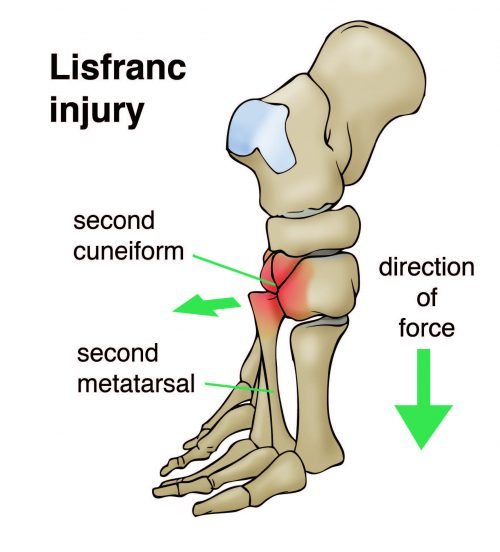Do you require any assistance? Simply reserve your appointment online below
Midfoot sprain
Individualized orthopedic care that champions depend on
A Midfoot Sprain is a common type of foot sprain that affects the ligaments in the middle of your foot.
The Midfoot Sprain can start as a small injury that can worsen as instability increases due to sprained ligaments.
The severity of the injury can vary from simple to complex, involving many joints and bones in the midfoot.
Injury to the Lisfranc joint is not a simple sprain that should be simply ignored. It is a severe injury that may take many months to heal and may require surgery to treat.

Causes of of Lisfranc injury

Symptoms of Lisfranc fractures may appear similar to many other foot injuries. This is why it is very important to have any foot injury properly diagnosed. Common symptoms of Lisfranc injuries include:
Midfoot Sprains occur when a large amount of force or weight is applied through the center of the foot. Football, hockey, and other contact sports can cause a Midfoot Sprain when the heel is lifted off the ground and weight is applied – through someone falling, etc. – onto the foot.
Another cause is due to the toes being forcefully pressed together causing the middle of the foot absorb strain.
Falling when your foot is in a fixed position.
Falling directly onto the toes when your foot is pointed straight down: this causes the midfoot to absorb too much weight.
Signs and symptoms of Lisfranc injury (Mid foot injury)
The most common symptoms of Lisfranc injury include:
The top of foot may be swollen and painful.
There may be bruising on both the top and bottom of the foot. Bruising on the bottom of the foot is highly suggestive of a Lisfranc injury.
Pain that worsens with standing, walking or attempting to push off on the affected foot. The pain can be so severe that crutches may be required.
If standard treatment for a sprain (rest, ice, elevation) does not relieve pain and swelling, you should seek care from an orthopaedic surgeon.
Diagnosing Lisfranc injury(mid foot) injury
Physical examination. First, a doctor may look for signs of bruising. Bruising can be a sign of a ligament tear, blunt trauma, sprain, or fracture.
Doctors may also gently squeeze different areas in the midfoot, a doctor may also check for midfoot injury by holding the toes and moving them up and down, bend and twist the front of the foot to check if a person feels pain to check for pain.
Imaging tests. Imaging tests are the best way to confirm a diagnosis of a Lisfranc injury.
X-rays will show any broken bones, as well as the alignment of the Lisfranc joint complex. They may take X-ray images of the uninjured foot for comparison.
In some cases, CT scans or MRIs will be used. These tests provide a more detailed image of the foot than an X-rays, and are better for looking at softer tissues. They may be more common in cases that could involve surgery.

Surgical Treatment of Lisfranc injury

Surgery is recommended for all injuries with a fracture in the joints of the midfoot or with abnormal positioning of the joints. The goal of surgical treatment is to realign the joints and return the broken bone fragments to a normal position.
Internal fixation. In this procedure, the bones are positioned correctly and held in place with plates or screws.
Because the plates or screws will be placed across joints that normally have some motion, some or all of this hardware may be removed at a later date. Occasionally, the hardware may break before it is removed. This is not unusual when screws or plates span bones that have some movement.
Metal can fatigue and fail under these conditions. Most often surgery is successful even if some of the hardware fails
Fusion. If the injury is severe and has damage that cannot be repaired, fusion may be recommended.
A fusion is essentially a “welding” process. The basic idea is to fuse together the damaged bones so that they heal into a single, solid piece.
The joints in the midfoot have very little motion and mainly transfer stress to the front of the foot. Therefore, patients who do require fusion surgery can still have a relatively normal gait.

You are in Great Hands
Non surgical treatment of Lisfrac injury(Mid foot)
In some simpler cases of Lisfranc injury, where the ligaments are not completely torn and there are no fractures or dislocations, treatment may include wearing a cast for as little as 6 weeks. During this period, no weight can be put on the injured foot.
Nonsurgical treatment plan includes wearing a non-weight bearing cast or boot for 6 weeks. You must be very strict about not putting weight on your injured foot during this period.
This then progresses to weight bearing in a removable cast boot or an orthotic.
Your doctor will want to follow up with you regularly and take additional x-rays to make sure your foot is healing well. In the course of follow up, if there is any evidence that the bones in the injured joint have moved, then surgery will be needed to put the bones back in place.

Recovery from a Lisfranc injury depends on its severity and the success of the surgery. Most surgeries will require 6-12 weeks of wearing casts and special walking boots.
Physical therapy and rehabilitation will also take time. Full recovery may occur after a year, but this can vary greatly. It may take longer than a year for athletes to regain their full strength and mobility. It is important to work closely with doctors and refrain from physical activity unless it is approved first.
Lisfranc fractures are serious, and even successful treatments may produce undesired side effects. These problems can include a reduced range of motion or strength, despite a period of rehabilitation. Arthritis and chronic pain may also occur from damage to the cartilage in the joints.
